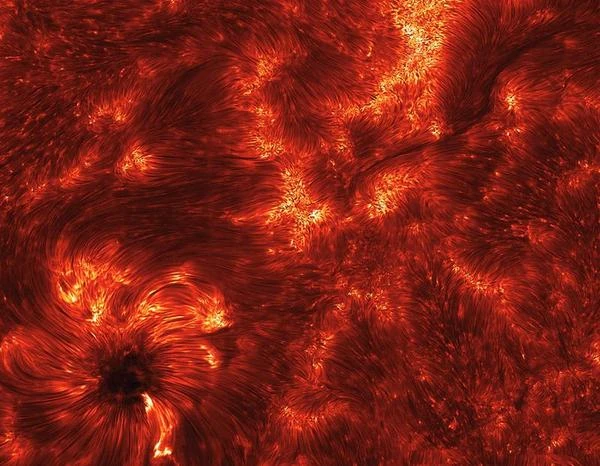
The Sun produces energy through nuclear fusion in its core, where the temperature exceeds 15 million kelvins. Each fusion of four protons (hydrogen nuclei) generates a helium nucleus and releases energy in the form of elementary particles, including gamma photons. However, these photons do not travel in a straight line to Earth. They begin a long journey through the dense and opaque solar interior, where they are constantly absorbed and re-emitted. This random process, called radiative random walk, takes on average between 10,000 and 170,000 years to reach the photosphere.
In the radiative zone (≈ 0.2 to 0.7 solar radii), the plasma is so dense that the mean free path of a photon is only a few millimeters to a few centimeters. At each interaction, it loses energy, gradually shifting from the gamma domain to the visible and infrared. The photon thus does not retain its identity: it is a continuous flux of re-emissions that preserves the overall energy, but not the initial particle.
Once it reaches the photosphere (about 500 km thick), the matter finally becomes transparent enough for the photon to escape. It is then free to travel in a straight line at the speed of light \(c \approx 3 \times 10^8\ \mathrm{m/s}\), unhindered by matter.
The average distance from the Sun to Earth is 149,597,870 km. Thus, a photon takes about 8 minutes and 20 seconds to cover this distance. This final step, although quick, is only possible after an odyssey of tens of thousands of years within the Sun. What we see from the Sun is therefore information that is already very old on the scale of its production.
This journey reveals the extraordinary density of the stellar core and the quantum nature of radiative diffusion processes. It also reminds us that visible light is only the tip of the iceberg of energy produced by deep and slow nuclear reactions. Observing the Sun, particularly via neutrinos, allows us to test these invisible timescales.
| Phase | Duration | Distance | Mechanism |
|---|---|---|---|
| Core → Radiative Zone | 10,000 to 170,000 years | 0.2 to 0.7 R☉ ≈ 139,268 km to ≈ 487,438 km | Radiative diffusion: emission of gamma photons from nuclear fusion (proton-proton cycle), followed by a random path due to the high opacity of the plasma Main interactions: absorption and re-emission by ions (notably Fe, H⁺, He²⁺), Compton scattering Spectral evolution: gradual energy loss of photons, shifting from gamma to ultraviolet |
| Convective Zone | A few days | 0.7 to 1.0 R☉ ≈ 487,438 km to ≈ 696,340 km | Thermal convection: the plasma becomes thermally unstable, hot cells rise and cold cells sink Transport by mass movements: rather than by photons, it is the ionized matter that transports energy Average speed: ≈ 1 to 2 km/s Structure: granular convective cells visible on the Sun's surface |
| Photosphere → Earth | 8 min 20 s | 1 AU ≈ 149,597,870 km | Rectilinear propagation: visible photons escape into space without significant interaction Constant speed: \( c \approx 3 \times 10^8\ \mathrm{m/s} \) Attenuations: possible disturbances by Earth's atmosphere (Rayleigh scattering) but not in interplanetary space Observed spectrum: white light (≈ 5778 K), peak in the visible (Planck's law) |
Sources: NASA - The Sun, ESA Helioviewer, Nature 2005 - Photon diffusion in the solar interior.